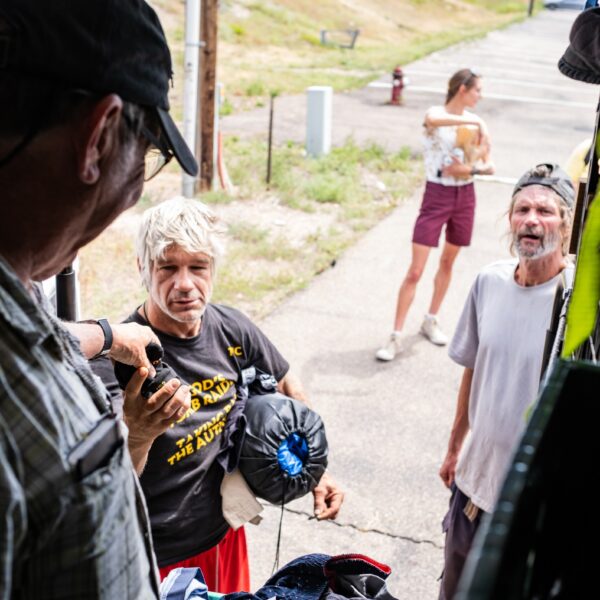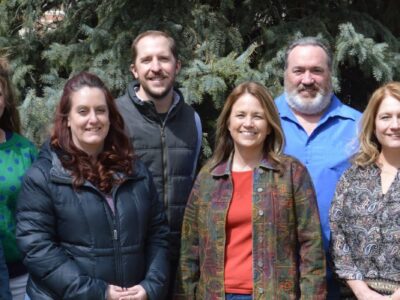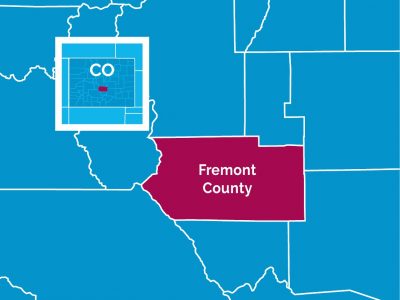Four years ago, the Fremont County team had 97 people experiencing chronic homelessness in their community. Now, it’s down to five, on the way to three.
In 2021, Fremont County, Colorado, became the twelfth community to reach the functional zero milestone for veteran homelessness. In the subsequent years, they have sustained that significant achievement and their next milestone lies within sight: functionally ending chronic homelessness.
Achieving functional zero indicates anyone who experiences homelessness in a community does so only briefly, is rehoused successfully, and is unlikely to return to homelessness again. For Fremont County to end chronic homelessness, fewer than three people would be experiencing chronic homelessness at any given time.
Solving homelessness for a chronic population is particularly challenging due to issues with documentation, verifications, and additional support needs for this vulnerable population. But with a collaborative team, committed leaders, and the knowledge from their previous functional zero milestone, Fremont County plans to join the other three communities that have ended both chronic and veteran homelessness — and this goal is shared by the whole team.
“If we’re able to be a part of the solution or a part of the process, I think we’re all eager and ready to do it,” said Jennifer GoShay, Coordinator Entry System Program Director at Loaves and Fishes Ministries, the lead agency in Fremont County.
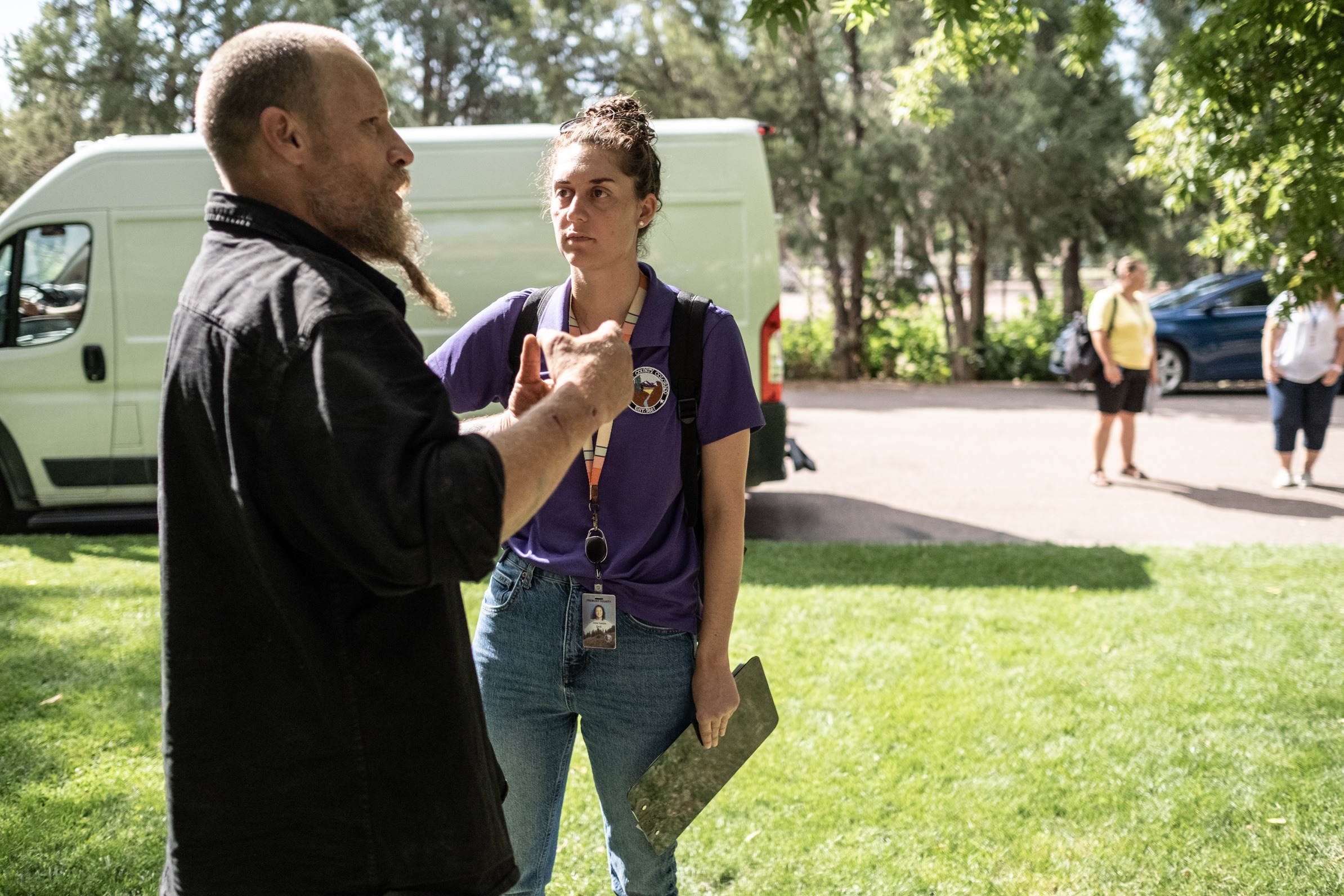
Challenges of chronic homelessness
To understand Fremont County’s journey toward functional zero for chronic homelessness, it’s crucial to grasp the complexities of this population. The federal government defines chronic homelessness as a condition affecting individuals with a documented disability who have faced homelessness for at least a year – or repeatedly over three years.
“When I think about ending chronic homelessness and what I’ve seen in the process of this over the years, it’s really about life and death.”
jennifer goshay, Coordinator Entry System Program Director at loaves and fishes ministries
While the population of people experiencing homelessness in any community is an ever-changing picture, chronic homelessness can be especially variable. It is a designation people can enter into at any time based on the amount of time they have experienced homelessness.
As Nikki Reynolds, former Recovery Support Care Manager at Solvista Health, emphasizes, verifying a disabling condition and documenting the length of a person’s experience of homelessness can be especially hard with this population.
“You have to document at least one encounter a month for that year where the person’s been homeless. And that’s been a barrier in a way, especially for the people living off grid.”
While that person may have been experiencing homelessness for months, if they haven’t made verified contact with a service provider, those months technically don’t “count.”
Fremont County’s rural and vast geography compounds this problem. Cañon City is the largest town in Fremont County, with a main drag spanning four miles through town, flanked by mountain ranges on either side. While the city is easily navigable by car, public transportation is minimal. People experiencing homelessness cannot easily access resources throughout Fremont County due to its sheer size.
“When I think about ending chronic homelessness and what I’ve seen in the process of this over the years, it’s really about life and death,” GoShay said. ”It really comes because these individuals have been experiencing homelessness for so long and have that diagnosed documented disabling condition, so it really comes down to life or death.”

Addressing the resource gap
Unlike veteran homelessness, which typically receives more funding and housing vouchers from places like VA, chronic homelessness lacks similar resources. Without a single organization able to provide services for people experiencing chronic homelessness, the lead agency in Fremont County, Loaves and Fishes Ministries, knew they had to solve for this.
“When we really started working hard on ending chronic homelessness, we did not have a lot of housing resources available,” said DeeDee Clement, Executive Director at Loaves and Fishes Ministries. “We really relied on what we call the CoC [Continuum of Care] voucher. But since then we’ve gotten some other vouchers that have helped us place our chronic families in.”
Though people experiencing chronic homelessness can make up less than 20% of a community’s homeless population, they often rely heavily on homeless services due to the compounding effects of health conditions, mental illness, substance use disorders, physical disabilities, or other impacts of deteriorating wellness.
“For individuals with severe mental illness or individuals that have been homeless for a decade, they need more than just housing,” Reynolds noted. “They need ongoing intensive case management to be truly supportive of that person’s wellbeing. We certainly don’t want to add another faulty experience to their history or to cause them to have more mistrust in the system.”

Contributing to the solution
Despite facing significant hurdles, Fremont County has successfully assembled a cohesive team of leaders and service providers dedicated to ending chronic homelessness.
“Our community has had to grow our case conferencing team, and our improvement team has grown by service providers that meet the need for that substance abuse and mental illness and disabilities. I think it’s been pretty organic,” GoShay said
This team is truly cross-sector and inter-agency. In 2022, Clement directly invited executive directors of key community organizations to join their team. These leaders were from all the service providers, law enforcement, the Bureau of Land Management, county commissioners, the city council department, the Department of Human Services, Solvista Health, and even the Mayor’s office.
As GoShay explained, Clement intentionally leveraged her executive director role to involve other leaders. “She would reach out and ask ‘Do you want to be at the table, to be part of the conversation and hear what we’re doing toward solutions, and be part of that?’”
Local landlords have also contributed to Fremont County’s progress — and they will be critical to reaching their functional zero goal. Clement and GoShay recognize the importance of local property managers and owners willing to give tenants a chance, even if they have not always had positive experiences.
“You can have all the vouchers in the world and no units or no landlord that’s willing to take the voucher,” said GoShay. “So it’s a partnership that has to continue to be built and developed and fostered and appreciated.”
Growing the outreach team
The outreach team’s expansion has played a pivotal role in the ongoing efforts to end chronic homelessness. Clients in this population may struggle to trust the system that may have failed them in the past. Sometimes, an individual is wary of a specific service provider. Loaves and Fishes Ministries has not only been able to bring on several new key roles internally, but they’ve also expanded their roster of local service providers.
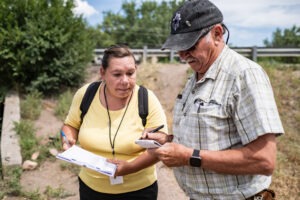
Street Outreach Case Manager,
Loaves and Fishes Ministries, working with United Methodist Church volunteer Jack Hagan (right) handing out food, clothing and other essentials to unhoused residents in Fremont County, Colorado. Photo credit: Jason Houston
“Each one of those agencies is a part of our outreach team,” GoShay said. “And so they’re going out on the street and meeting someone where they’re at, trying to engage them to build a relationship and then say, here’s how I can support you, after you know me and begin to trust me.”
Reynolds agrees with the need for trust and stresses the importance of building and recognizing that community comes in many forms.
“But also in the people we serve — they also need community. When we go and do street outreach, they’re with their friends, they’re connecting, and it takes time for us to feel like their community. But that’s a beautiful experience when you feel that trust emerging.”
With transportation being such a significant barrier in the county, this expanded outreach team takes steps to help meet the needs of their clients, whether it’s to get to a grocery store, go to court, get a shower, or other necessities.
“There’s warm handoffs in that collaboration. And people are stepping outside of their job descriptions to meet someone’s needs,” GoShay said. “Maybe this week I’m helping with this part of someone’s journey, but next week it may be someone else.”
In 2023, the outreach team widened its reach to encompass outlying areas within the county and even neighboring counties. Officers from the Bureau of Land Management now collaborate closely with Fremont County’s outreach leads, reaching out when concerns arise about the well-being of unsheltered individuals in the more isolated regions of the county.
“We’re really working out the kinks and learning to work even more effectively with these high-needs individuals. And we each have a purpose in this teamwork,” Reynolds said.

Pursuing Zero for All
Even with an end to chronic homelessness in their sightline, Fremont County continues to find ways to improve their system — and to make it more equitable across all races and ethnicities.
“We have room for growth there to look at what’s really happening with those other populations,” said GoShay. “Are they being housed at the same rate and have the same opportunities?”
After they reach and sustain functional zero for chronic homelessness, the community’s next goal is “Zero for All,” meaning they want to reach functional zero for all populations in Fremont County.
“It really is everybody on deck here. And I think that is what’s going to make the huge impact,” Reynolds said. “And that’s going to help us get to functional zero. But also it will also keep the door open for the next individual that may be entering.”
